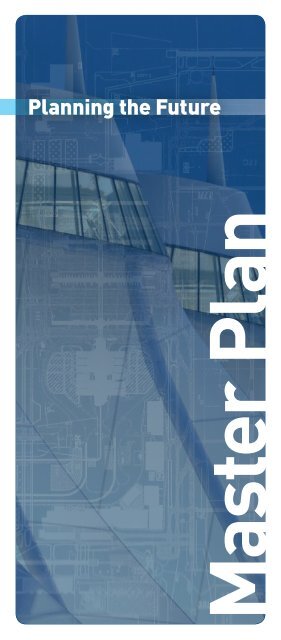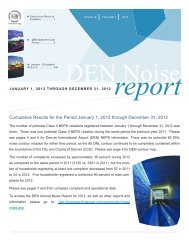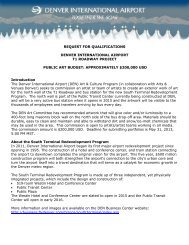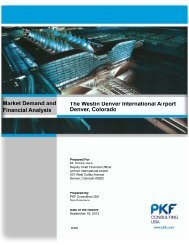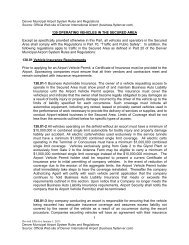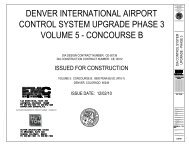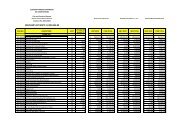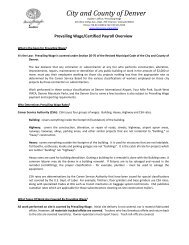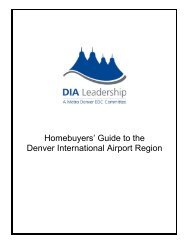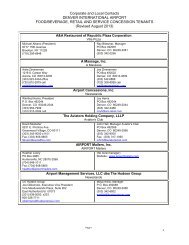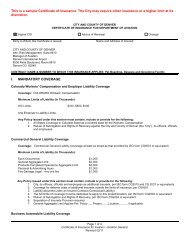Master Plan - DIA Business Center Home Page - Denver ...
Master Plan - DIA Business Center Home Page - Denver ...
Master Plan - DIA Business Center Home Page - Denver ...
- No tags were found...
You also want an ePaper? Increase the reach of your titles
YUMPU automatically turns print PDFs into web optimized ePapers that Google loves.
Imagine a Great Airport<strong>DIA</strong> was designed to be <strong>Denver</strong>’sport to the world.As with many great public work projects, theidea for <strong>Denver</strong> International Airport sprang fromneed. In the early 1970s, farsighted communityleaders were already envisioning a largerairport to accommodate <strong>Denver</strong>’s burgeoninggrowth. Stapleton Airport, which had openedas <strong>Denver</strong> Municipal Airport in 1929, was virtuallylandlocked and nearing its capacity, with noisepollution and flight delays becoming increasinglycontentious issues.The search for a new site began, culminatingin the acquisition of 53 square miles of farmland inneighboring Adams County. <strong>Denver</strong> annexed mostof this property, an enormous political challengethat required the astute guidance of business andcivic leaders, and, ultimately, approval by votersfrom both counties. Building <strong>DIA</strong> was a seminalevent that raised <strong>Denver</strong>’s collective consciousnessby showing how big dreams can be realized.Table of Contents1 – Imagine a Great Airport2 – <strong>DIA</strong> Today4 – What is a <strong>Master</strong> <strong>Plan</strong>?6 – Why Update the <strong>Master</strong> <strong>Plan</strong>?8 – Key Considerations10 – Timeline and Process12 – Airport Efficiency14 – Airport Activity Forecasts18 – Short-term Needs18 – Long-term Needs20 – Runways22 – Terminal and Concourse Alternatives20 – Terminal and Concourse Alternatives24 – Landside and Support Facilities Alternatives26 – Sustainable Development28 – Moving ForwardStapleton International Airport<strong>Denver</strong> International Airport / 1
<strong>DIA</strong> TodayFor four consecutive years (2005to 2008) <strong>DIA</strong> has ranked as the topairport for business travelers inNorth America.An airport is a reflection of a community andits spirit. <strong>Denver</strong> International Airport has cometo symbolize many things about our region:architectural ingenuity, technological innovation,visionary planning and – perhaps most important –our community’s belief in itself and confidence inits future. Although metro <strong>Denver</strong> ranks as the20th-largest metropolitan area in the US, <strong>DIA</strong>served more than 51 million passengers in 2008,ranking as the fifth-busiest airport in NorthAmerica and the 10th busiest in the world. ColoradoDepartment of Transportation estimated <strong>DIA</strong>’sannual economic impact to the state at morethan $22 billion dollars, while accounting for overhalf of the state’s total aviation jobs. <strong>DIA</strong> is trulythe most important economic engine in the stateof Colorado.Encompassing 53 square miles of land, <strong>DIA</strong> is thelargest airport in North America and the secondlargestairport in the world. This large land areais designed to limit the impacts of airport activityon the airport’s neighbors and provides room forthe airport to expand and grow. The enormouspotential of <strong>DIA</strong> to serve a prominent role in theglobal aviation system is due primarily to theairport’s room to grow. <strong>DIA</strong> is part of a larger planfor the landlocked city of <strong>Denver</strong>, opening thepath to markets around the world and providing astimulus for economic growth in the region. Thevery foundation of <strong>Denver</strong>’s role as a world-classcity is <strong>Denver</strong> International Airport.2 / <strong>Master</strong> <strong>Plan</strong><strong>Denver</strong> International Airport / 3
What is a <strong>Master</strong> <strong>Plan</strong>?<strong>DIA</strong>’s <strong>Master</strong> <strong>Plan</strong> Update is fundedin part by a grant from the FAA, withthe remainder of the study fundedby <strong>Denver</strong> International Airport. Notaxpayer monies are involved to payfor the master plan study.A master plan is one of the most importantdocuments from an airport management andoperation perspective as it guides future growthand development. An airport master plan providesa road map for efficiently meeting aviationdemand through the foreseeable future whilepreserving the flexibility necessary to respondto changing industry conditions. <strong>DIA</strong>’s currentmaster plan was developed in 1988 and providedguidance for the airport through 50 million annualpassengers. With that threshold now reached,<strong>DIA</strong> management is in the process of updating themaster plan. The new plan will provide developmentguidelines through 2030.The goal of a master plan is to build the overallframework needed to guide future airportdevelopment. The plan must also allow the airportto keep pace with aviation growth cost effectively,while also considering potential environmental andsocioeconomic impacts. <strong>Master</strong> plans also providethe airport with the tools to react to uncertaintiesby examining key trends in the aviation industry,such as changing airline business models,improvements in technology, and local/regionaleconomics that could affect airport activity.4 / <strong>Master</strong> <strong>Plan</strong><strong>Denver</strong> International Airport / 5
Key ConsiderationsThere are numerous elementsthat must be balanced to developa master plan that will meet thedynamic needs of <strong>DIA</strong>’s variedstakeholders.Key considerations for developing <strong>DIA</strong>’smaster plan:- Ensure safety and security- Keep costs practical and affordable- Maintain consistency with <strong>DIA</strong>’s vision,mission and goals- Maintain consistent and coordinateddevelopment that matches city andregional development plans- Minimize impact to current operations- Optimize operational efficiencies and flexibility- Emphasize customer service and satisfaction- Allow airport to respond to the changingneeds of the dynamic aviation industry- Continue to support <strong>DIA</strong>’s role as the keyeconomic engine for the region and the state- Meet sustainability and environmentalrequirements and continue <strong>DIA</strong>’s leadershipin environmental stewardship- Reserve and maintain land uses on-airportto permit logical, phased development thatis both flexible and responsive- Allow the airport and its terminal to remainarchitecturally iconic- Allow for enhancement of nonairline revenue8 / <strong>Master</strong> <strong>Plan</strong><strong>Denver</strong> International Airport / 9
Timeline and ProcessThe development of an airport master plangenerally takes three years from start to finish.At the end of the process, the FAA will grantapproval, allowing the airport to move forward withdevelopment plans. As demonstrated here, publicinput begins early on and continues throughoutthe process. <strong>Denver</strong> Mayor Hickenlooper alsoconvened a <strong>Master</strong> <strong>Plan</strong> Advisory Committee whichincludes representatives from all stakeholdergroups including government, businesses, airlines,and community organizations.AIRFIELDConcept Evaluation andRecommendation ProcessStep 3 of the master plan process includes conceptevaluation and recommendation. The process isdepicted graphically below.TERMINALLANDSIDESUPPORTanager<strong>Master</strong> <strong>Plan</strong> ProcessAlternativeConceptsSTEP 1STEP 4SCREENINGInitial TechnicalEvaluation of Needs- Inventory- Forecasts- Analysis- Coordination with FAAPreliminaryRecommendations- Best options to meet ourfuture needsINTEGRATIONScreenedConceptsngIntegratedConceptsSTEP 2Detailed Technical AnalysesIdentify NeedsStakeholder Meetings& InputSTEP 5Final StakeholderMeetingsSCREENINGEVALUATIONShortlist IntegratedConceptsWe Are HereSTEP 3Alternative Solutions- What are the options tomeet our future needs?STEP 6FAA Approval of AirportLayout <strong>Plan</strong> (ALP)- EIS ScopingPreparation of Airport Layout <strong>Plan</strong>PreferredAlternativeStakeholder input begins in step 2 andcontinues through step 5.10 / <strong>Master</strong> <strong>Plan</strong><strong>Denver</strong> International Airport / 11
Airport Efficiency<strong>DIA</strong> is one of the most efficientairports in the world due to thevision of the airport’s originalplanners.Situated on 53 square miles of land, <strong>DIA</strong> currentlyhas one terminal building, three concourses andsix runways. <strong>DIA</strong> planners designed enough roombetween concourses to allow two wide-bodyaircraft to push back from opposite concourseswhile two more aircraft taxi between them.The pinwheel layout of the airport’s six runwaysand wide spacing between runways add to theairport’s efficiency. Three aircraft can typicallyland simultaneously at <strong>DIA</strong>, even in adverseweather conditions.Passenger movement also follows a simpleflow-through principle. While <strong>DIA</strong> may seemintimidating to infrequent travelers, everything isarranged in a logical, consistent pattern – fromparking to ticket counter to train to concourse.These elements have led to <strong>DIA</strong>’s ranking as oneof the least-delayed airports in the US – goodnews for both airlines and passengers.16R16LNWES12,000’3,658m16,000’4,572m12,000’3,658m82617L34RC17RE470B34LATERMINAL12,000’3,658m12,000’3,658m72512,000’3,658mto I-70to <strong>Denver</strong>Peña Boulevard35L35R12 / <strong>Master</strong> <strong>Plan</strong><strong>Denver</strong> International Airport / 13
Airport Activity Forecasts<strong>DIA</strong>’s annual airport activity isestimated to grow by 20- to25-percent by the 2015/2020time period.One of the first steps in the master plan processis to develop forecasts of aircraft and passengeractivity. To allow the airport to adapt to futurechanges, several alternate scenarios for futuregrowth at the airport have been examined.BaseForecast:Growth rates reviewed in comparisonto FAA’s Terminal Area Forecast:84-percent growth in passengersand 77-percent growth in operationsScenario 1: High growth rate (compared tothe baseline): 108-percent growthin passengers; 98-percent growthin operationsScenario 2: Decrease in hubbing/connectingactivity: 64-percent growth inpassengers; 60-percent growthin operationsScenario 3: An evolution to a larger aircraftfleet: 84-percent growth inpassengers; 64-percent growthin operationsScenario 4: Higher international growth as<strong>Denver</strong> grows into an internationalgateway: 103-percent growth inpassengers; 90-percent growthin operationsBased on these forecasts, <strong>DIA</strong>’s annual airportactivity is estimated to grow by 20- to 25-percentby the 2015/2020 time period, and by 70- to100-percent by the 2030/2035 timeframe. Thisgenerally translates into a 60- to 90-percentincrease in overall facility needs at <strong>DIA</strong>.14 / <strong>Master</strong> <strong>Plan</strong><strong>Denver</strong> International Airport / 15
Short-term NeedsAs part of the master plan, <strong>DIA</strong> has identifiedshort-term needs (2015/2020 timeframe).These include:- One additional runway (7 total runways)- Concourse expansion – 20-plus new gates(total) on any or all Concourses (A, B, or C)- Additional international passenger processingand gates- Capacity expansion of the airport people mover- Baggage system improvements- Expansion of passenger security screening- FasTracks rail station- On-airport hotel- Parking and rental car expansionsIMAGE?Long-term NeedsIn addition to meeting the short-term needs ofairport activity, <strong>DIA</strong> is taking a longer term viewof the airport to plan for activity through the2030/2035 timeframe. Like visionary plannersof the past, we want to prepare the airport forfuture generations and leave a legacy that cansupport growth and expanded economic activity.- Additional runways (9 or 10 total)- 100-plus additional gates- Concourse D (2020/2025)- Concourse E (2030/2035)- Significant international passengerprocessing expansion- Expansion of passenger security screening- Taxiway improvements- More aircraft deicing positions- Potential for doubling of rental car space- Fourth lane on Peña Boulevard- Public and employee parking expansion(near doubling)16 / <strong>Master</strong> <strong>Plan</strong><strong>Denver</strong> International Airport / 17
Runways<strong>DIA</strong>’s runway configuration isthe envy of the airport industry.The airfield design – which includes nointersecting runways – allows for smooth andefficient flow, which reduces delays. As the maphere shows, future runways follow the samepinwheel pattern, allowing <strong>DIA</strong> to maintain oneof the most efficient airfields in the world.To accommodate the forecast growth in airservice, a seventh runway will be needed by the2015/2020 timeframe. <strong>DIA</strong> has not yet decidedwhich runway will be built next. We will considerseveral issues before selecting the seventhrunway, including:- Optimization of existing runways and taxiways- Weather conditions – specifically the coordinationof deice pads and snow-removal operations- Minimization of taxi times and flight times- Accommodation of new/emerging aircraft types- FAA Control Tower needs for line-of-sightN16R16LWESCURRENT RUNWAYSFUTURE RUNWAYS (2009-2030)FUTURE RUNWAYS (beyond 2030)1516R16,000’4,572m12,000’3,658m8L812,000’3,658m2626R17C17L1834RC17RE470B3334L34LATERMINAL12,000’3,658m12,000’3,658m712,000’3,658m25Peña Boulevard35C35R3635Lto I-70to <strong>Denver</strong>7R25L18 / <strong>Master</strong> <strong>Plan</strong><strong>Denver</strong> International Airport / 19
NWESBATERMINALTerminal and Concourse AlternativesrdnmentEExisting Template Expansion ConceptWhen <strong>DIA</strong> was first designed, the original longtermconcept was for terminal expansion to thesouth and concourse expansion to the north.This concept remains one of the alternatives forfuture development. The concept componentsand related issues follow.- Telescoping of current concourses to theeast and west- Concourses D and E built to the north- Second terminal building to the south ofcurrent Jeppesen Terminal- Concerns about capacity and funding of thepeople-mover and baggage systems- People-mover remains the must-ride systemto all concourses other than Concourse ACURRENT TERMINALCURRENT CONCOURSESFUTURE TERMINAL/CONCOURSE EXPANSIONDEDCBAJEPPESENTERMINALCURRENT TERMINALCURRENT CONCOURSESFUTURE TERMINAL/CONCOURSE EXPANSION20 / <strong>Master</strong> <strong>Plan</strong><strong>Denver</strong> International Airport / 21
26RTerminal and Concourse AlternativesEE26DEast/West Terminal and Concourse ConceptIn this concept, a strong central terminal iscreated for both C <strong>DIA</strong>’s passengers and tenants.N- Includes two new concourses – orientedWEnorth-south B – one west and a second oneSeast of the current Jeppesen Terminal- Defers the need for Concourses D and Ebeyond 2030/2035A- Alleviates the need for an expensive expansionof the people-mover system and new, biggerTERMINALtunnels for the planning periodDSouth Terminal ConceptThis concept provides for a new terminalcomplex in the C existing cargo area south of thecurrent Jeppesen Terminal.- A new terminal B complex could be uniquelybranded as an international or a low-costterminal- Requires the A relocation of most of <strong>DIA</strong>’ssupport facilities south of the terminal andwill require a people-mover system toTERMINALconnect passengers, employees and visitorsto the existing terminal/concourse complexoulevardCURRENT TERMINALCURRENT CONCOURSESCURRENT RUNWAYSFUTURE TERMINAL/CONCOURSE EXPANSIONFUTURE RUNWAYSFUTURE TERMINAL/CONCOURSE EEXPANSIONSUPPORT FACILITIESCURRENT TERMINALCURRENT CONCOURSESFUTURE TERMINAL/CONCOURSE EXPANSIONDs AlignmentWNEDCSCBBAAJEPPESENTERMINALJEPPESENTERMINAL22 / <strong>Master</strong> <strong>Plan</strong><strong>Denver</strong> International Airport / 23
Landside and Support Facilities AlternativesIn addition to runways andterminal/concourse facilities,the master plan will include areview of landside and supportfacilities. As the airport grows,one of the areas of focus needsto be how to best accommodatedemands for these facilities.The review includes:- Parking (both public andemployee)- Rental car facilities- A potential GroundTransportation <strong>Center</strong> (GTC)- Cargo facilities- General aviation operations- Firefighting operations- Airline and airportmaintenance facilities- The fuel farmLandside AlternativesCURRENT RUNWAYSFUTURE RUNWAYSEXISTING SUPPORT FACILITIESNWESE470Peña BoulevardFasTracks Alignmentto I-70to <strong>Denver</strong>15337GTC7R16C 16L16R16,000’ 12,000’4,572m 3,658m34R34L 34CTERMINAL12,000’3,658m25RENTAL CARSPUBLIC PARKINGCBA25L8L817C17R12,000’3,658m35C35L12,000’3,658m17L12,000’3,658m35R18362626RThese are all critical elementsfor <strong>DIA</strong>’s long-term success,and various alternatives areunder review.Support FacilitiesAlternativesSCALE5 miles0 10 miles16C16LCURRENT RUNWAYSFUTURE RUNWAYSEXISTING SUPPORT FACILITIES1516R8L26RFUTURE SUPPORT FACILITIES:ALTERNATIVE 116,000’4,572m12,000’3,658m812,000’3,658m26ALTERNATIVE 2ALTERNATIVE 3ALTERNATIVE 434RC17R17C17L18NE470BWSE3334L34CATERMINAL12,000’3,658m12,000’3,658m12,000’3,658m725Peña Boulevard35C35R36FasTracks Alignment7R25L35Lto I-70to <strong>Denver</strong>24 / <strong>Master</strong> <strong>Plan</strong><strong>Denver</strong> International Airport / 25SCALE5 miles
Sustainable Development<strong>DIA</strong> is one of the greenestairports in the world.Colorado is perhaps most well-known for itsnatural beauty and recreation, and leaders fromboth the public and private sectors are proactive inprotecting the environment for future generations.<strong>Denver</strong> International Airport has also establisheditself as a leader in environmental stewardship.In January 2009, <strong>DIA</strong> hosted the first meeting ofthe Global Reporting Initiative for internationalairports. This group – which includes world-classairports such as Munich and Frankfurt – willdevelop environmental guidelines specific toairports. <strong>DIA</strong> was the first US airport askedto join this prestigious group.The following are <strong>DIA</strong>’s key environmentalachievements:- First international airport in the US todevelop and implement a facility-wideEnvironmental Management Systemcertified to ISO 14001 (2004)- First airport in the US to be accepted intothe US Environmental Protection Agency’sNational Environmental PerformanceTrack Program (2006)- Received FAA Environmental StewardshipAward (2007)Ongoing environmental initiatives include recycling,the use of alternative fuels, management ofthe deicing process, and wildlife and wetlandsmanagement. In August 2008, <strong>DIA</strong> installed atwo-megawatt solar facility on its land. This facilitywill generate more than three million kilowatthours of electricity annually and reduce carbonemissions by five million pounds per year. <strong>DIA</strong>’smaster plan process and future growth willincorporate sustainable principles every step ofthe way.26 / <strong>Master</strong> <strong>Plan</strong><strong>Denver</strong> International Airport / 27
Moving ForwardAt full build out, <strong>DIA</strong> willhave over 300 gates and canaccommodate over 100 millionannual passengers.Imagine an airport twice the size of the presentone. As one of the largest economic engines forthe region and the state, <strong>DIA</strong>’s growth will continueto propel the <strong>Denver</strong> metropolitan area as one ofthe most successful and desirable in the countryin the coming decades.Size is one of the most significant competitiveadvantages in the global aviation industry. <strong>DIA</strong> isthe envy of airports around the world because ofthe room to grow to accommodate the dynamicneeds of airlines, passengers and stakeholders.The challenge facing current planners is toensure that this tremendous asset is preserved.This can be achieved through communication,cooperation and coordination with stakeholdergroups, including governments, businesses,airlines and community organizations. Ultimatelythe entire region and state will benefit from thecontinued growth of <strong>DIA</strong>.Fortunately, <strong>Denver</strong> International Airport ispoised to embrace the future. A visionary masterplan coupled with experienced, professionalmanagement and staff and supportive communityleaders and stakeholders will ensure <strong>DIA</strong>’splace as the jewel in the crown of world-classairports for decades to come. For updatesregarding <strong>DIA</strong>’s <strong>Master</strong> <strong>Plan</strong>, please visitwww.flydenver.com/masterplan.Comments can be submitted in writing tomasterplan@flydenver.com.Flight Times from <strong>DIA</strong>LondonFrankfurtDENVERNew YorkShanghaiTokyoLos Angeles2 HoursCairo4 HoursMexico CityDubaiMumbai6 HoursSingapore8 Hours10 HoursSydney12 HoursBuenos Aires14 Hours16 HoursNote: Times are approximate28 / <strong>Master</strong> <strong>Plan</strong><strong>Denver</strong> International Airport / 29
www.flydenver.com


